| Animal facilities at the Laboratoire d’Ethologie Expérimentale et Comparée (LEEC) - Université Paris 13 |
| |
___________ |
|
|
|
| |
|
The LEEC hosts 3 animal facilities, housing rodents, social insects and marine worms. We keep and breed only animals of wild origin. This ensures that our animals still show a wide spectrum of their natural behaviours, essential for our studies of reproductive strategies, patterns of chemical communication and on the ontogeny of behaviour including animal personality. |
| |
|
|
|
|
| |
|
Rodents of wild origin |
| |
|
|
|
|
| |
|
We are currently keeping two species of rodents of wild origin in our facilities, the house mouse and the mound-building mouse.
The house mouse is commonly found in urban areas in many countries all over the world and is the origin of the laboratory mouse. House mice are polygynous (i.e. one male monopolizes several females), and females frequently show communal nesting.
The mound building mouse is a monogamous species found in agricultural areas in Central and Eastern Europe. The juveniles build a mound in autumn out of soil and plant materials under which they survive the winter.
We are currently carrying out behavioural experiments mainly focussed on chemical communication, individual differences in personality types and studies on the early developmental environment including parental behaviour and sibling interactions. |
| |
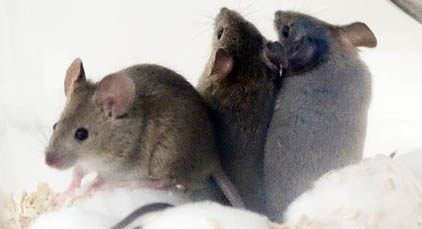 |
| Sibling group of juvenile domestic mice. (Photo Tatiana Forestier) |
| |
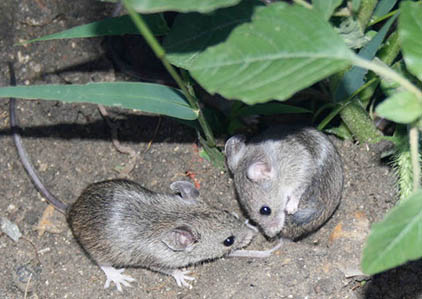 |
| Two adult mound-building mice. (Photo Patrick Gouat) |
| |
|
| |
|
|
|
|
| |
|
Social insects |
| |
|
|
|
|
| |
|
In our insectarium, we are keeping different taxa of social insects: ants, termites, wasps and bumblebees.
Around 30 species of ants (mainly tropical ones) are permanently kept and bred in the insectarium of the LEEC. These different species were collected in Europe, the Americas and Asia, and they are bred in different rooms according to their needs in ambient temperature and humidity. The species we keep (e.g, Ponerines, Cérapachyines, Formicines, Myrmicines) differ strongly in their biological characteristics, such as in their social organisation, division of labour, existence of reproductive conflicts and learning capacity.
We also keep and breed several xylophagous tropical termite in order to study their chemical communication (by pheromones) as well as their defensive and reproductive strategies.
Furthermore, we regularly keep different colonies of bumble bees and Pollistes wasps to study chemical communication and reproductive conflicts. Bumble bees and wasps form annual colonies, and thus these colonies need to be regularly renewed.
Typically, our insectarium contains about 500 colonies of insects, with each of them containing of a few dozens to up to several thousand individuals. The maintenance of such an alive collection of various species of social insects requests as well the breeding of potential prey species serving as food (e.g., crickets and meal worm beetles). |
|
|
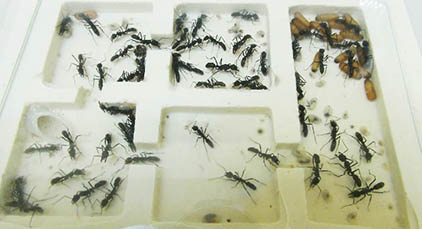 |
| Artificial nest of the ant Neoponera apicalis. (Photo Paul Devienne) |
| |
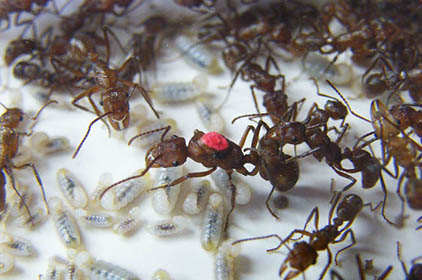 |
| Queen of Ectatomma tuberculatum (marked with a red colour spot) with workers around. (Photo Paul Devienne) |
| |
 |
| Workers and soldiers of the termite Nasutitermes lujae. The soldiers are recognizable by their nasus, a pointed prolongation of their head by which they are able to secrete a sticky substance. (Photo David Sillam-Dussès) |
|
| |
|
|
|
|
| |
|
Marine worms (polychaetes) |
| |
|
|
|
|
| |
|
We keep microscopic marine polychaete worms by rearing them in marine water. The water temperature is kept constant and the polychaetes are fed with spinach. These are interstitial worms and are expected to spend most of their life in the dark. We keep several different species; some of which have separate sexes, i.e. some worms are males and others are females. Others are simultaneous hermaphrodites, i.e. each worm produces both eggs and sperm.
The variety of sexual systems among these organisms makes them especially suitable for research on reproductive biology and we study their parental care (yes, they care for their eggs and young!) their mating behaviour and mating conflict. We aim to understand how the evolutionary transition between hermaphroditism and separate sexes occurred by sexual selection. |
|
|
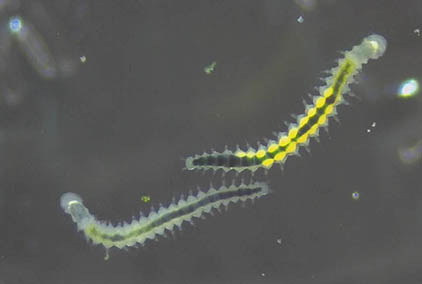 |
| Two hermaphrodite adult polychaete worms (Ophryotrocha diadema). The worm at the top right has many mature eggs, which appear as yellow, whereas the other worm has no eggs. (Photo Virginie Boutias) |
|
| |
|
|
|
|






